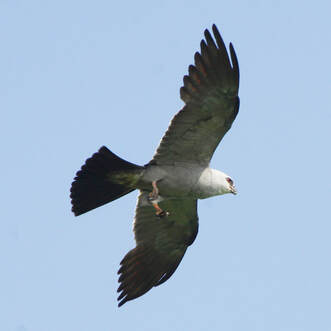 Mississippi Kite, by Dan Vickers. Mississippi Kite, by Dan Vickers. by Steve Phenicie, Georgia Audubon member If Mississippi Kites were circus performers, they might be the Flying Wallendas. If they were military pilots, they might be the Blue Angels. The printed page cannot adequately describe the aerial maneuvers these birds can perform, but if you’d like to see for yourself, search “Mississippi Kite Barrel Roll” on YouTube for a demonstration. When this bird isn’t flying just for fun, it can catch large flying insects high in the air, often holding them with one foot and eating them while on the wing. It can also skim low to catch prey on or near the ground. Major items in the diet include cicadas, grasshoppers, katydids, beetles, and dragonflies; it also eats moths and bees, and lesser numbers of frogs, toads, snakes, bats, rodents, small birds, and turtles. It won’t turn up its beak at road-kill either. Despite the name, they aren’t particularly associated with the state of Mississippi or the Mississippi River. During the breeding season they are most common in southern South Carolina, Georgia, and Alabama and on the Great Plains of Texas, Oklahoma, and Kansas. In the winter they take off for the interior of South America. Except during migration, you’re unlikely to see one in metro Atlanta. The coloration of this bird is a mix of gray and black, becoming pale gray-white on the head and in the secondaries of the wings. The wingtips and tail are black. Juveniles are streaky, with brownish chests and underwings, and have banded tails. In size, they’re between a crow and a goose and have long, pointed wings. The tail is fairly long and square-tipped. Nesting tends to be in loose colonies, with the site in a tree usually near the edge of woodlot 20 to 35 feet above ground, although it can be up to 140 feet. The nest, built by both sexes, is a rather flimsy platform of dead twigs, lined with green leaves. Adults add greenery throughout the season. The female lays one to two white eggs, and incubation is by both parents for 29 to 31 days. Both parents care for the young. First they may feed the nestlings mostly insects, regurgitated into the nest, with larger prey coming later. The young may climb out of the nest onto nearby branches when about four weeks old and make their first flights at about five weeks. Adults feed them for at least eight weeks after hatching. In Georgia, Mississippi Kites are more common in the coastal plain and on the coast rather than in the Piedmont. They like to nest along the edges of expansive bottomland forests of many of the larger Coastal Plain rivers, in large forest tracts near pastureland, and in some smaller forested areas near cities/towns, according to the Breeding Bird Atlas of Georgia. In late summer, they team up with Swallow-tailed Kites to form foraging flocks. One reliable spot for these flocks is in the Glennville area (west of Savannah), specifically the Skeens Farm. Last year there was also a group near Watkinsville/Athens. During the breeding season, some of the locales you might see them are Ocmulgee Mounds National Historical Park in Macon, Oxbow Meadows near Columbus, Okapilco Floodplain and Pasture in Brooks County near Quitman, and Paulk's Pasture near Brunswick.
18 Comments
Virginia
6/18/2021 08:35:55 am
I’ve spotted a white-tailed kite in my tree here in Forsyth, Ga. if flew in this morning. There are no links for people to just type in what they’ve spotted. I read your article. This may be a Mississippi Kite but the right to face short beak seems to indicate otherwise. I know it would be rare.
Reply
Virginia
6/18/2021 08:40:30 am
After checking the specs again, it must’ve been a Mississippi Kite, it was closer to the 14”. What a great treat this morning!!!
Reply
Georgia Audubon
6/18/2021 08:54:12 am
Yes, it's almost certainly a Mississippi Kite, but still a great treat north of Atlanta. Enjoy!
Randy
8/30/2022 01:06:49 pm
I have been seeing what I’m almost certain a kite in west central Gordon county GA . It was in bottom land next to Oostanaula river. I seen about three times last two weeks.
Reply
Lisa
7/9/2023 02:49:14 pm
Yes. There were several there last summer. Near the old cotton fields.
Laurie
8/21/2021 02:33:16 pm
I live next to the main campus of CSU and ive had at least 4 of them in my tree at one time I am so excited to see them and have been able to get some good photos. I love listening to them
Reply
Susan Waits
3/21/2022 03:20:07 pm
I have several bird feeders in my backyard and recently I spotted a Mississippi Kite hanging out over the feeders.
Reply
Bubba M.
7/6/2022 07:46:40 pm
Have a mating/nesting pair absolutely destroying my free range chickens. I've lost 6 in the last 2 weeks, 2 layers and 4 pullets. But they are a site to see for sure. I think this is all part of the process and a good lesson for my 7 year old granddaughter about nature and the circle of life.
Reply
Patrick Daugherty
7/13/2022 04:16:23 pm
Sighted a Mississippi Kite soaring above neighborhood between Peachtree City/Tyrone near Line Creek. Beautiful bird.
Reply
Rhonda Lawson
8/7/2022 08:22:14 pm
We have Swallow Tail Kites and Mississippi Kites that are hunting together. I live in Colquitt County Georgia. The Swallow Tails have been here for a while now and they hunt in huge flocks. The Mississippi Kites have just shown up here and are extremely aggressive hunters flying at ground level whilst I'm putting up my poultry. I have seen the Swallow Tails hunting the Canadian Geese that have been migrating . That was a sight to see. They were swirling in swirls of about 30 birds each in each swirl on both sides of the v formation taking out geese so easily. There was areas 8 to 9 v Formations of geese and like I said at least 20 Swallow Tails to each swirling group on each side of the v formations. . It was spectacular to see. The Mississippi Kites are in a group of at least 30 to 40 . And are hunting with a huge group of Swliwtsils that nest on Barnesville Road.
Reply
RJS
8/9/2022 10:09:35 am
I live in East Athens and definitely have a pair of Mississippi Kites in tall pine in my backyard. Have been hearing their wispy call for the last week and saw them this morning for the first time! Have never seen them before.
Reply
We have had at least two pairs of swallow tailed kites and numerous Mississippi kites hunting above the pastures around our home in Comer Georgia for a few weeks now. It’s amazing to watch them fly and the swallow tails are beautiful!
Reply
Josh
6/23/2023 01:06:52 pm
Mississippi kite seen in Warner Robins
Reply
Tommy Parker
8/14/2023 10:27:37 am
Been seeing them in Macon, Ga. for 3 years now.
Reply
Bubba M.
8/15/2023 07:31:52 am
This past weekend I watched a parent Kite training 2 fledglings as they zoomed overhead, did rolls and dives. I thought I saw them smiling.
Cassie Delash
8/8/2023 04:42:01 pm
We have had a pair of Mississippi kites around us all summer. We live just outside of Griffin, Ga. My son loves birds, and it took us a long time to identify this pair! We love them!
Reply
Tommy Parker
8/15/2023 01:03:54 pm
Bluebirds, otters and Jack Russell puppies have always brought smile to my face. Now these Ms. Kites do too.
Reply
Harris York
8/22/2023 01:00:39 pm
I have two adult(breeding)Mississippi kites with a juvenile living in one of my trees in Rome, GA. The call they make is so unique it’s clear what they are. I have never seen them before, they are new to our neighborhood this summer.
Reply
Your comment will be posted after it is approved.
Leave a Reply. |
AuthorBirds Georgia is building places where birds and people thrive. Archives
April 2024
Categories |

 RSS Feed
RSS Feed

